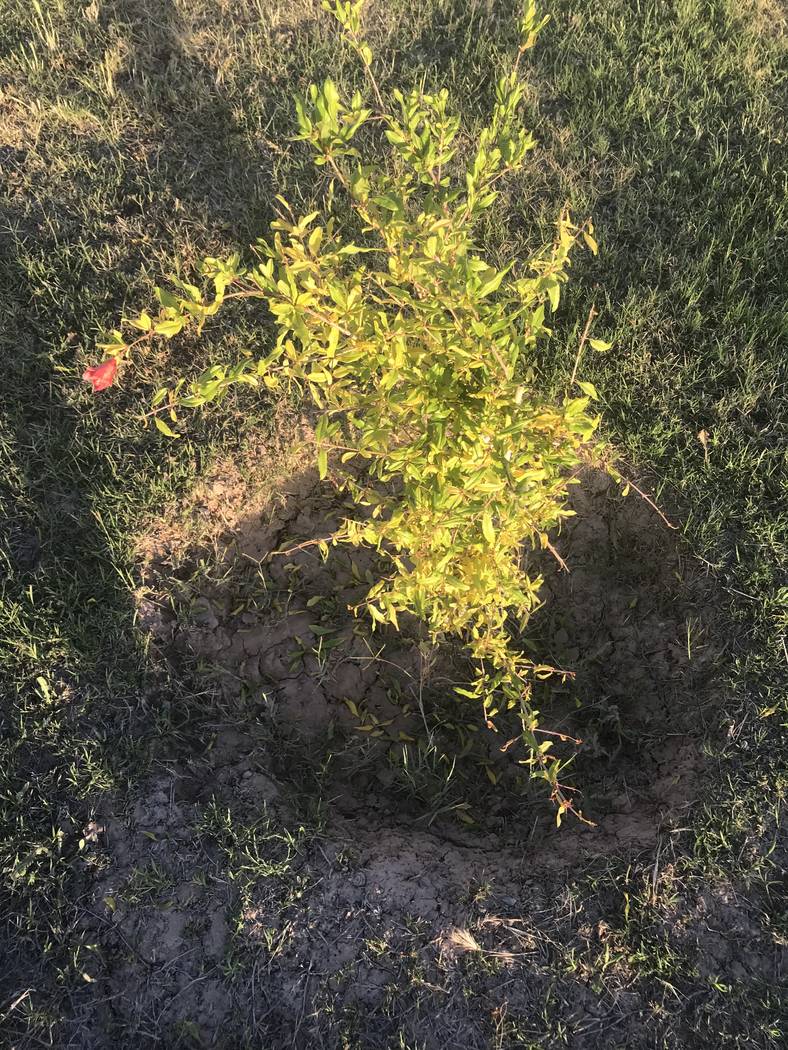Weed killer may cause yellow leaves on pomegranate

Q: Eleven of my 50 young pomegranate trees have leaves yellowing and dropping off. I water this area once a week by flooding. I sprayed a weed killer, 2, 4-D, near the pomegranates, but I protected each one with plastic to avoid damaging the trees. Where did I go wrong here? If the weed killer is the problem, is there any way to save them?
A: When I first saw your pictures, I thought the yellow leaves were because the soil was too wet. But I read they were watered only once a week.
Watering once a week in midspring should pose no problem if the soil does not stay wet until the next irrigation. If the soil is a heavy clay and remains wet, that could cause leaf yellowing and dropping.
I lean more toward chemical damage from the weed killers, but let’s talk about other possibilities.
In the picture, I saw grass growing close to the pomegranates. Grass growing close to these plants will not cause yellow leaves but would cause them to grow more slowly. Particularly if the grass is Bermuda grass. So it’s always a good idea to remove grass at least 3 feet from a fruit tree.
Leaf yellowing could come from a lack of nitrogen in the soil. That can be the case if the trees are in competition for nitrogen with grass.
But if you are fertilizing that grass regularly, there is probably plenty of nitrogen escaping to the pomegranates. Removing grass 3 feet from the tree reduces competition for all fertilizers but particularly nitrogen.
Now on to the most likely problem: weed killers. It helped that you covered each of the trees with plastic before spraying. It’s even more important that you spray this kind of weed killer at correct times: when temperatures are cool and there is absolutely no wind. Hot soil surfaces cause dandelion killers such as 2, 4-D to volatilize (turn into a vapor) and move very easily with the very slightest air movement.
Damage from 2, 4-D is easy to identify when the plant is growing and producing new leaves; new leaves are deformed. If the plant is not growing and producing new leaves, leaves turn yellow and drop.
The branches that supported these leaves might or might not die as well. There is no remedy for this. All you can do is wait and see what happens.
I am concerned with the plastic. Make sure the same side of the plastic is in contact with the plants, and you don’t accidentally wrap the plant with a contaminated side.
I think a better weed killer to use for your purpose might be Roundup. It does not volatilize as easily as 2, 4-D. For it to move inside the plant and damage it, the spray must land on green leaves or green limbs. If you prune pomegranates so their lowest foliage is only knee height from the ground, this weed killer is less likely to cause plant damage.
Keeping grass 3 feet from the trunk also helps. A small plastic bucket with a hole drilled in the center of the bottom and attached to a spray wand will help contain the spray and direct it toward the weeds.
Q: When composting we are told to mix “browns” and “greens” together for a good balance of carbon from the “browns” and nitrogen from the “greens.” I am puzzled. All living things have both until they are composted. To me, the browns add fluffy aeration to the soil while the greens clump together in the compost pile. Is it possible that the mix of browns and greens is as much for texture as it is for carbons and nitrogen?
A: This is a huge question that requires a lot more space than this column permits. Compost is used as an amendment for soils for two reasons: because it can positively change the chemistry of the soil and the structure of the soil. I will try to answer it more completely in my blog.
The terms “browns” and “greens” are a simplification for the average person to make it easier to choose the correct plant ingredients when making compost. Dry wood, or sawdust made from wood, is about 50 percent carbon by weight. The amount of nitrogen in sawdust is about 400 or 500 times less than the carbon. So, the carbon to nitrogen ratio of sawdust (a brown) is about 400 or 500 carbons for every single nitrogen.
The “greens” referred to come from green plant parts such as tree leaves, grass clippings, vegetables, etc.
A good compost should have no more than 40 carbons for every nitrogen (40:1). It can have fewer carbons than this but no more. To get this ratio lower, green amendments (more nitrogen) must be added to this sawdust.
It just so happens that food waste is one ingredient that fits the bill because it has about 20 carbons for each nitrogen. By the way, this is about the same ratio as coffee grounds, a plant addition which is brown in color but considered a green. The brown and green rule can’t be taken 100 percent literally.
Many composts use farm animal manure, rich in nitrogen, to add nitrogen to browns. Farm animal manures (brown in color) can be as low as 12 carbons for each nitrogen. Human manure (also brown in color) can be as low as 6 carbons for each nitrogen. On top of that, animal manures are easier to collect and transport for composting.
When browns and greens are mixed together in the right proportion and composted, voilà. The finished compost has the magical carbon to nitrogen ratio less than 40:1. I usually aim for a carbon to nitrogen ratio close to 20:1 in a finished compost.
Finished compost with a carbon to nitrogen ratio of 40 (C:N = 40) has only a small amount of nitrogen to give to plants. A richer compost (C:N = 20) can supply much more nitrogen and acts like a fertilizer when mixed with the soil or applied on top of the soil near plants.
But carbon and nitrogen aren’t the only fertilizers supplied by compost. The composting process releases all the nutrients contained in the ingredients. What goes in, must come out.
So much for the chemistry. Compost also changes the physical structure of a soil. It acts very similar to peat moss and coir, making it more fluffy, while providing many more nutrients to plants compared with either peat moss or coir.
Q: My Asian pears look sickly again this year with yellow leaves. Last year after they were planted the new growth was yellow and again it’s happening this year.
A: There are several possibilities why plants have yellow leaves when they’re young.
One possibility is planting the tree too deep. Fruit trees must be planted the same depth they were when growing in the nursery. Those fruit trees that are grafted or budded must have this dogleg point of attachment above ground.
Sometimes they get planted too deep by accident. If the hole is dug deep and the soil is amended, it’s possible the tree will sink deeper than intended after it’s planted. Sinking deeper combined with wet soil falling around the trunk can rot the trunk. That is the reason it is best not to dig the hole deeper than needed to accommodate the roots unless there is a drainage problem.
The first sign wet soil is around the trunk and it’s starting to rot are yellowing leaves. If not corrected, the rotting can kill the tree.
If the bud union is below the soil, water can rot the union, first yellowing the leaves followed by tree death. In milder climates, the top part of the tree might grow roots, and the benefit of a rootstock is lost.
Another reason for yellow leaves is borer infestation. You would think that trees coming from a nursery wouldn’t have insect problems, but sometimes they do.
After planting hundreds of fruit trees, I have observed there are about two trees out of every 100 that will have borers. Trees most susceptible include peach, nectarine and apple. Others are also susceptible but less so in my experience.
Water drainage from the soil can also be a problem. If watering too often and the roots stay wet, they will rot. Rotting roots decrease the plant’s health. The first sign of rotting roots is yellowing leaves. Check the soil moisture and make sure trees are not watered heavily every day.
Sometimes our desert soil is not improved enough at the time of planting. In very poor desert soils, I like to see about 50 percent compost mixed with the soil when planting. Less compost is needed in other soils, but adding some amount adds nutrients and improves rooting of plants.
Bob Morris is a horticulture expert and professor emeritus of the University of Nevada, Las Vegas. Visit his blog at xtremehorticulture.blogspot.com. Send questions to Extremehort@aol.com.



















